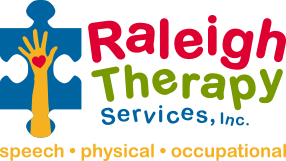Getting Ready for Kindergarten
Filed under: Education & School, Parent Education, Raleigh Therapy Services

Summer is flying by quickly making way for schools supplies, lunch money, and homework. Some seasoned parents are counting down the days ready for the return of the routine, while others are beginning to prepare their soon-to-be kindergarteners for this new life adventure.
If you are among the latter, we want you to know you’ve got mama friends, family and our entire Raleigh Therapy Services team cheering you and your new student on to school success.
“The start of the school year can cause any parent to stress and panic, especially those sending their little ones off to kindergarten,” said Allison Crumpler, Raleigh Therapy Services Speech-Language Pathologist and Director of Clinical Compliance. “These new students will find themselves in a different learning environment with new teachers, unfamiliar classmates and a wealth of information to learn and retain—who wouldn’t find that overwhelming?”
Fortunately, there are many activities and skills you can introduce now to give your child a head start on all that awaits her in kindergarten:
Holding a Pencil and Cutting
Children entering kindergarten should be able to hold a pencil and cut with scissors correctly. You can help your daughter perfect these tasks by:
- Helping her strengthen her fine motor skills by stringing beads, picking up small pieces of paper using their index finger and thumb, etc.
- Working on using the appropriate three-finger grasp when using pencils, crayons, and scissors
- Letting her practice cutting by asking her to cut pictures out of old magazines and coloring books
Buttoning and Zipping
Kindergarten teachers like students to be able to button, zip, and fasten their clothing before and after using the restroom. Some children will also be ready to learn how to tie their shoes. Help your student grasp these tasks by:
- Practicing buttoning and zipping clothing items she isn’t wearing
- Wearing her “school clothes” around the house ahead of time to practice taking on and off, buttoning and zipping
- Using a shoelace board or box to practice tying shoes
Remembering an Address and Phone Number
In addition to knowing their first and last names, children entering kindergarten should also learn their home address and phone number. Help your daughter retain this information by:
- Repetition—say it over and over and over again and asking you’re her repeat after you
- Making up a catchy, rhyming tune that incorporates her phone number and address
Name Writing
A kindergarten teacher will want your child to be able to write their first name on the first day of school. While the writing will not be perfect at this age, it should be legible. You can help her practice writing her name by:
- Letting her trace her name to become more familiar with the letters and shapes of the letters
- Using a dry erase board or chalkboard to write her name as it makes it easy to wipe off and start again
Recognizing Letters
Your daughter will learn the letters of the alphabet, including lower- and upper-case letters, during her kindergarten year. You can give her a leg up on letter identification by:
- Asking her to point out letters in the books you read during story time
- Using letter flashcards
- Tracing letters in the sand at the beach or the playground
- Playing with magnetic letters on the fridge and asking her to find named letters
- Going on an alphabet hunt through the house to find toys and objects that start with the same letter
Identifying Letter Sounds
In addition to knowing the alphabet letters, your daughter will also benefit from knowing the sounds* that the letters make. Activities you can use to work on letter sound recognition include:
- Going on a scavenger hunt around the house to find objects that start with named sounds
- Using letter flash cards to make the sound of the pictured letter
- Playing rhyming games or asking her to say words that all start with a certain letter sound
As you share letter sounds with your child, be sure to model the sounds correctly. For example, “t” is “t-t-t” and not “tuh-tuh-tuh.”
Print Concepts
Your student will need to know the front, back, and spine of a book along with being able to identify the author, title, and illustrator. She’ll also need to recognize that pages are read from left to right. Help her expand her knowledge of print concepts by:
- Pointing out the parts of the book and then asking her to identify them
- Demonstrating that words and pages are read from left to right by using your finger to move along the words as you say them
Counting
Your student will know how to count to 100 by the end of the kindergarten school year. Help your child hone in on her counting skills now by:
- Asking her to count all sorts of items throughout her daily routine—blueberries on her plate, her building blocks, her pile of stuffed animals and more
- Showing her number flash cards and working with her to put them in order
- Looking at numbers on a digital clock and talking about the numbers that come next
“Kindergarten is a big milestone for children and their parents. Incorporating some of the anticipated kindergarten learnings at home, will help in the preparation process and hopefully instill confidence in new students,” added Crumpler.
Image Credit: Shutterstock.com


